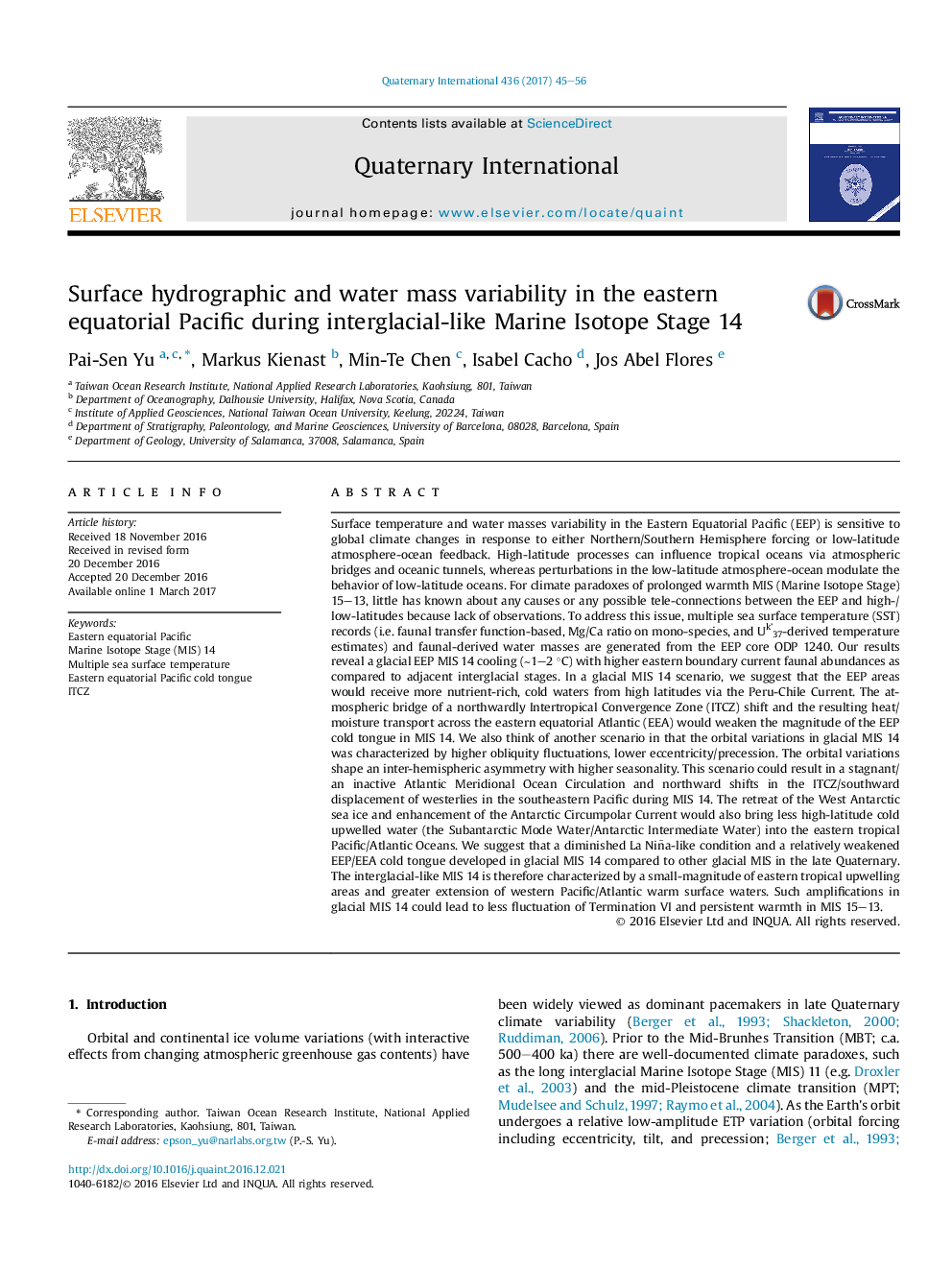| کد مقاله | کد نشریه | سال انتشار | مقاله انگلیسی | نسخه تمام متن |
|---|---|---|---|---|
| 5113541 | 1377938 | 2017 | 12 صفحه PDF | دانلود رایگان |
عنوان انگلیسی مقاله ISI
Surface hydrographic and water mass variability in the eastern equatorial Pacific during interglacial-like Marine Isotope Stage 14
ترجمه فارسی عنوان
تنوع هیدروگرافی سطحی و آب در اقیانوس آرام شرقی در طول مرحله ایزوتوپ دریایی مانند 14
دانلود مقاله + سفارش ترجمه
دانلود مقاله ISI انگلیسی
رایگان برای ایرانیان
موضوعات مرتبط
مهندسی و علوم پایه
علوم زمین و سیارات
زمین شناسی
چکیده انگلیسی
Surface temperature and water masses variability in the Eastern Equatorial Pacific (EEP) is sensitive to global climate changes in response to either Northern/Southern Hemisphere forcing or low-latitude atmosphere-ocean feedback. High-latitude processes can influence tropical oceans via atmospheric bridges and oceanic tunnels, whereas perturbations in the low-latitude atmosphere-ocean modulate the behavior of low-latitude oceans. For climate paradoxes of prolonged warmth MIS (Marine Isotope Stage) 15-13, little has known about any causes or any possible tele-connections between the EEP and high-/low-latitudes because lack of observations. To address this issue, multiple sea surface temperature (SST) records (i.e. faunal transfer function-based, Mg/Ca ratio on mono-species, and Uk'37-derived temperature estimates) and faunal-derived water masses are generated from the EEP core ODP 1240. Our results reveal a glacial EEP MIS 14 cooling (â¼1-2 °C) with higher eastern boundary current faunal abundances as compared to adjacent interglacial stages. In a glacial MIS 14 scenario, we suggest that the EEP areas would receive more nutrient-rich, cold waters from high latitudes via the Peru-Chile Current. The atmospheric bridge of a northwardly Intertropical Convergence Zone (ITCZ) shift and the resulting heat/moisture transport across the eastern equatorial Atlantic (EEA) would weaken the magnitude of the EEP cold tongue in MIS 14. We also think of another scenario in that the orbital variations in glacial MIS 14 was characterized by higher obliquity fluctuations, lower eccentricity/precession. The orbital variations shape an inter-hemispheric asymmetry with higher seasonality. This scenario could result in a stagnant/an inactive Atlantic Meridional Ocean Circulation and northward shifts in the ITCZ/southward displacement of westerlies in the southeastern Pacific during MIS 14. The retreat of the West Antarctic sea ice and enhancement of the Antarctic Circumpolar Current would also bring less high-latitude cold upwelled water (the Subantarctic Mode Water/Antarctic Intermediate Water) into the eastern tropical Pacific/Atlantic Oceans. We suggest that a diminished La Niña-like condition and a relatively weakened EEP/EEA cold tongue developed in glacial MIS 14 compared to other glacial MIS in the late Quaternary. The interglacial-like MIS 14 is therefore characterized by a small-magnitude of eastern tropical upwelling areas and greater extension of western Pacific/Atlantic warm surface waters. Such amplifications in glacial MIS 14 could lead to less fluctuation of Termination VI and persistent warmth in MIS 15-13.
ناشر
Database: Elsevier - ScienceDirect (ساینس دایرکت)
Journal: Quaternary International - Volume 436, Part A, 29 April 2017, Pages 45-56
Journal: Quaternary International - Volume 436, Part A, 29 April 2017, Pages 45-56
نویسندگان
Pai-Sen Yu, Markus Kienast, Min-Te Chen, Isabel Cacho, Jos Abel Flores,
